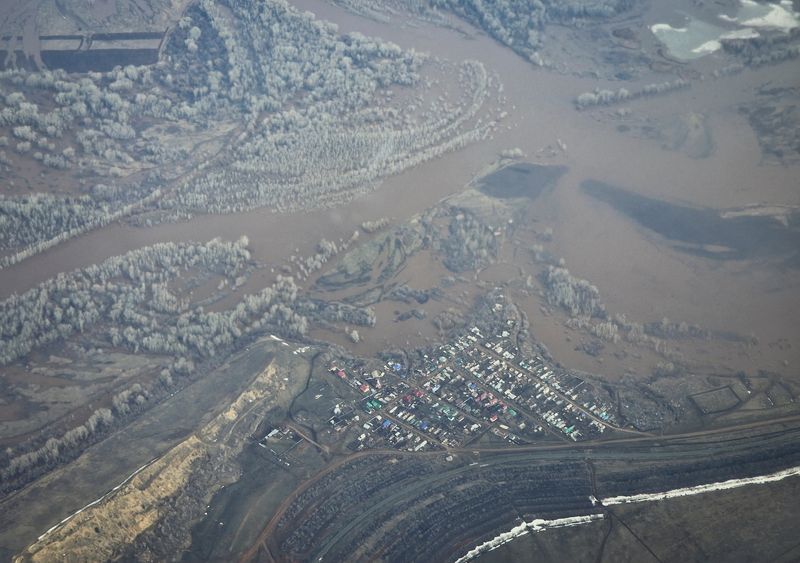By Guy Faulconbridge, Olzhas Auyezov
MOSCOW/ALMATY (Reuters) -Here is a summary of the impact of record floods which have swamped large areas of Russia and Kazakhstan:
WHICH AREAS ARE AFFECTED?
The worst hit areas in Russia are just to the south of the Ural Mountains, about 1,200 km (750 miles) east of Moscow.
Emergencies have been declared in the Orenburg and Kurgan regions of the Urals and in the Tyumen region in western Siberia, which is the largest hydrocarbon basin in the world.
The Ural river, which rises in the Ural mountains and flows through Kazakhstan into the Caspian Sea, burst through embankment dams in the Urals city of Orsk on April 5 and flooded parts of the city of Orenburg.
Some regions around the Volga, Europe’s longest river, have been flooded as has the Altai region of Siberia. Water levels were also rising in Tom river in the Tomsk region of Siberia.
At least 12,000 people in Russia are recorded as having been evacuated. Officials have stepped up bottled water supplies and Hepatitis A vaccinations were being conducted in flooded areas.
In Kazakhstan, more than 97,000 people have been evacuated. The worst hit areas mostly border Russia and are crossed by rivers flowing from or to Russia: Atyrau, Aktobe, Akmola, Kostanai, East Kazakhstan, North Kazakhstan and Pavlodar regions.
The Ural flows through the major Kazakh oil industry hub of Atyrau, where authorities have closed schools and mobilised thousands of people to reinforce river banks and build dams.
Kazakhstan has evacuated a number of villages along the Ishim, a tributary of the Irtysh, which along with its parent the Ob, forms the world’s seventh longest river system. Authorities expect flooding of the Ishim and another tributary, the Tobol, to peak by April 23-25.
Water levels are expected to reach their peak near the city of Patropavlovsk, the centre of the North Kazakhstan region, on Thursday or Friday.
WHAT ARE THE ECONOMIC RISKS?
– Some of the floods have occurred in key wheat producing areas of Russia, the world’s biggest wheat exporter.
– Russia is also the world’s second largest oil exporter. The Orsk oil refinery in the Urals declared force majeure on fuel supply from April 8, according to a document issued by plant owner Forteinvest and seen by Reuters.
It said the plant had been shut to avoid ecological risks and ensure labour safety. Last year the refinery processed 4.5 million metric tons (90,000 barrels per day) of oil.
– Over 8,000 farm animals have been killed by floods in Kazakhstan, and a special squad has been deployed by the agriculture ministry to dispose of the bodies and prevent the spread of disease.
– Hundreds of trucks carrying cargoes have got stuck in Kazakhstan as authorities closed roads damaged or threatened by floods.
WHY ARE THE FLOODS SO BAD?
Spring flooding is a part of life across the region as the harsh winter snows melt, swelling some of the mighty rivers of Russia and Central Asia. This year, though, a combination of factors triggered unusually severe flooding.
Russian emergency officials said the soil was waterlogged before winter and then frozen under very high snow falls which then melted very fast in swiftly rising spring temperatures and heavy rains.
Maria Shahgedanova, a professor of climatic science at Reading University, said moist soil going into winter, higher-than usual snowfall and a rapid temperature rise at the start of spring explained the scale of the flooding
“Within days temperatures went from zero to 17, 18 and even 20 degrees (Celsius). And that’s what caused a very, very rapid snowmelt,” she said.
While the heavy snow accumulation this winter was part of normal climatic variability, she said climate change is leading to heavier snowfalls in the north and east of the region that the rivers flow through which will likely cause larger spring flooding when snows melt.
“We’re looking at a 7% increase in (snow) precipitation where there is one degree temperature change”, she said.
Russia is by far the world’s biggest country by land area – about the size of the United States and Australia together. Russia’s boreal forests, or taiga, cover an area about equal to the United States and are the largest forested areas on earth so play a crucial role in the world’s climate.
In 2009 research commissioned by the U.S. National Intelligence Council on the impact of climate change on Russia to 2030, the authors said the rise in temperatures would lead to a series of complex issues for Russia.
Among them were the increased frequency of extreme climatic events including heavy rains, fires in Siberian peatlands and more frequent flooding of Russia’s Arctic rivers due to heavy rain and earlier breakup of river ice.
The paper stated that by 2015, there would likely be more flooding in river basins of the Archangelsk Region, the Komi Republic, the Ural area, and in the basins of Yenisei and Lena.
